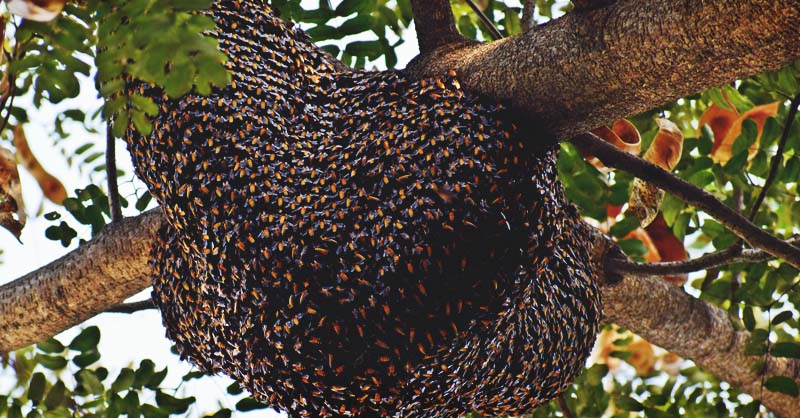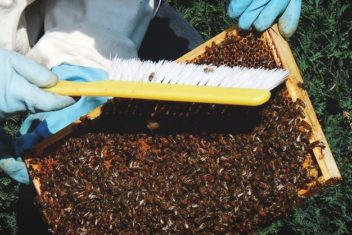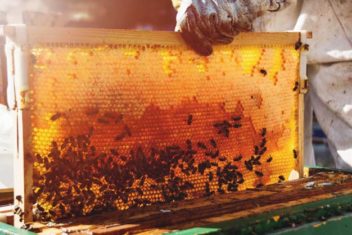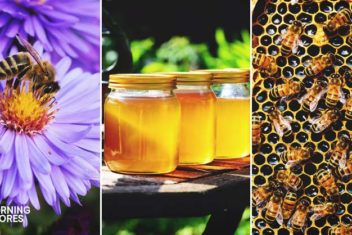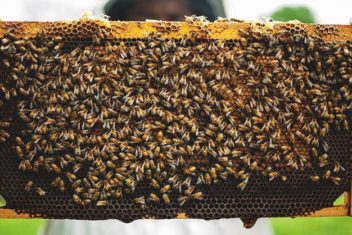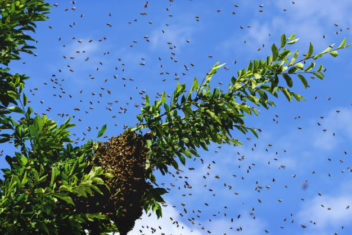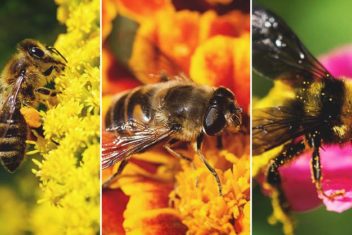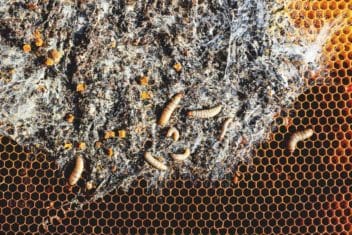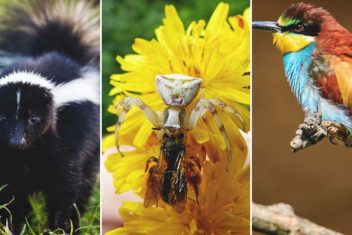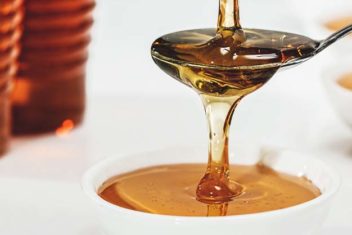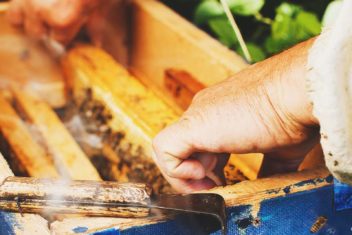If you are new to beekeeping or keen to venture into this highly satisfying venture, brushing up on common beekeeping problems will prepare you for the unknown and help prevent the loss of your hive.
Some of the most common issues are easily preventable, especially if you understand why they occur. It is time to get your bee-know-how up to date and ramp up your hive management regimen.
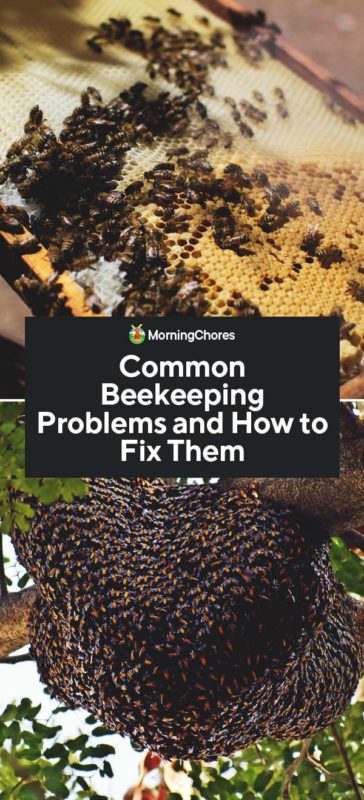
Swarming
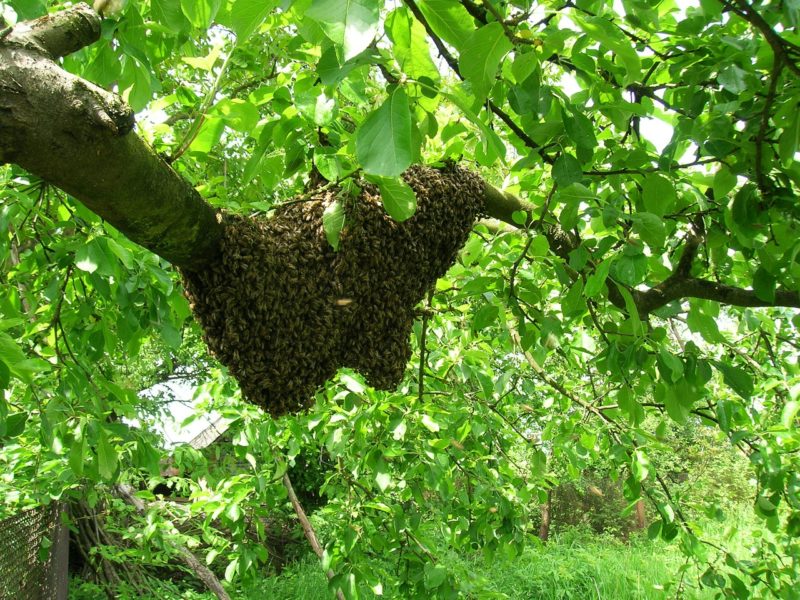
Swarming is a natural occurrence among honeybees. It is in their nature to split into two different colonies if something has made them a tad uncomfortable in their current hive.
When bees swarm, they produce swarm cells, which are cells that contain new, developing, queens. You will be able to recognize them by their atypical shape and large size. Honeybees will create a handful of these cells if they are planning a swarm.
Once these cells are placed, the hive splits into two, leaving one half of the colony with the swarm cells and the queen-to-be. The other half of the colony leaves with the current queen in search of a new place to set up shop.
When a swarm happens, anywhere from 10,000 to 30,000 bees will leave the hive at the same time. Before departure, they guzzle more honey to prepare for their journey and ensure they have adequate energy to establish a new hive.
Large swarms will look for a landing space, where they can rest with their queen while the worker bees set off to find a new location.
If you see a swarm, don’t panic, contrary to popular belief, swarms are not typically aggressive. They have just eaten a lot of food and are hanging out waiting for the worker bees to return with the specs on their new hive.
How to Prevent a Swarm
Even though swarming is a natural occurrence, it also means the loss of half your bee population. There are ways to catch a swarm and establish a new hive, but these are best left to the pros. It is easier to prevent the swarm by compensating your bees with what they need so they decide to stay put.
Here’s how to recognize, and prevent a swarm from happening:
1. Swarm Cells
If, while you are doing a routine check on your hive, you come across swarm cells, you will know that a swarm is going to occur in the near future.
To stop the swarm from happening, you can remove the developing queens, and this will stop half the hive from leaving. They would never leave the colony if there weren’t a backup plan for a queen.
This is only a band-aid to the problem, and only temporarily prevents the swarm from happening. The bees will keep making more swarm cells because the underlying cause of the swarm has not yet been addressed.
The good news is, removing these swarm cells buys you some time to figure out why a swarm is happening, and how you can prevent it.
2. Beat the Heat
If your bees are too hot, they may decide they need to find a new place to build their colony. If you do not have proper ventilation in your hive, your bees may leave in a swarm, or all together.
3. Outgrowing Their Hive
If you started with a small package of bees, around 10,000, you should expect your hive to grow over time. It is important always to assess the amount of space your bees have. If your hive is doubling, and tripling, make sure you add enough supers to give them enough space to continue to grow.
Since bees build from the bottom of a hive up, they may begin to feel crowded, even if there is more room at the bottom of the hive body for the whole bee family.
If your bees don’t have enough elbow room, nature will tell them it’s time to move on. Instead of losing your hive, you can consider moving the bottom hive body up to the top, giving your bees more space to grow upwards.
4. Hydration
It can be easy to assume that bees will go off and find a source of water but don’t forget how habitual a bee is. They love to stick to their beelines and highways, and if their water source dries up, they may decide to move their hive to a new location, closer to water. So always make sure your bees have access to water.
Lastly, if you have assessed your hive, and realize a swarm is still imminent, you can proactively split your hive and expand your bee operation with another, new hive nearby.
Splitting the Hive
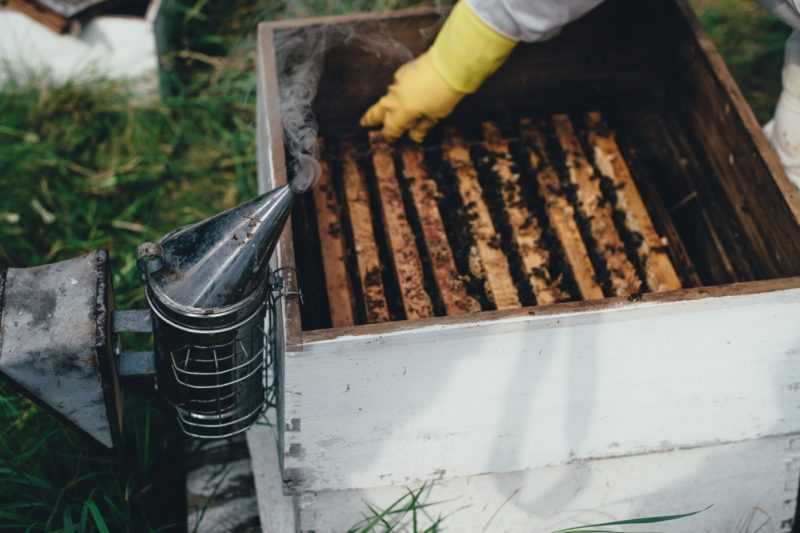
There may come a time, about a year or so after your bees have become established, that either a swarm is imminent due to overpopulation, or you have decided to expand your honey operation, or you would like to sell some of your bees.
In any of these situations, you will have to split your hive into two colonies, but before you do, make sure your hive is healthy and robust, and you have either ordered a new queen, or there are swarm cells present (new queens).
Before you attempt to split your colony, make sure your new hive is set up and ready to go (or your nuc box is prepared).
New hives should be at least 4 ft from the original hive; otherwise, your “new” colony may reenter the familiar hive rather than building in their new home.
Remember, bees are creatures of habit!
If the swarm cells are capped, or you have a new queen ready, you can begin to split the hive knowing that each colony will have their own queen.
Steps To Split Your Hive
1. Use your smoker to calm your hive.
2. Remove a frame with honey on it and place it into the empty (new) hive.
3. Find the current queen and put her into the new box along with the frame she is currently occupying.
4. Find additional honey-laden frames that have capped cells (not swarm cells—if you see new queens, remove them from these frames. Place them alongside the other frames. Then, use additional, empty, frames to complete your new hive.
5. Either your new queen (or the swarm cell queens) will now be able to take over the old hive while the previous queen builds a new queendom.
6. Feed both hives with sugar syrup regularly until they are established.
7. Check on your hives after about a week to make sure they are developing as new colonies.
Colony Collapse Disorder (CCD)
Colony Collapse Disorder is a mysterious problem amongst beekeepers’ hives. According to the EPA, there are many theories surrounding the cause behind this strange disappearing act. Luckily, the amount of disappearing colonies has declined within the last few years. Yes, strangely enough, entire hives are found abandoned.
Even though the hives have been vacated, food supplies may still be present, broods of capped cells, and sometimes even just the queen is left wandering around her empty kingdom.
As of now, there is no confirmed reason for a vacated hive; however, some of the possible reasons being researched are mites, pesticides, environmental change, cell phone radiation, and genetically modified crops – among many other theories.
Common Diseases Amongst Honeybees
Honeybees are susceptible to their diseases and illnesses, just like any other living being. Some are more dangerous, and common than others.
Here is a rundown of some of them:
1. Nosema
Nosema apis is a protozoan that causes digestive issues in bees that contract the disease. It causes weakness, fatigue, disorientation, and sometimes death. Think of it as the stomach flu for the bees.
Nosema is caused by protozoa spores that are present in bee feces, and are typically more prevalent after a long winter of defecating in the hive.
In frigid climates, bees are not able to leave the hive to relieve themselves, and being the cleanly critters they are, they try to keep their hive clean by licking it, thus contracting this virus.
Antibiotic treatment is available if you are comfortable giving it to your bees; otherwise, the removal of spore-filled frames may help prevent the spread of the disease. If your bees are strong and healthy, they may pull through on their own.
2. American Foulbrood (AFB)
AFB is a bacterial disease that attacks the brood of a beehive. It is highly contagious, and at present, there is no cure for it. If your hive contracts this deadly disease, the best course of action is to burn and bury the entire hive to prevent the spread of the disease to other honeybees.
American Foulbrood attacks only the brood of a hive but can be transmitted by adult bees. Signs that your colony has contracted AFD include, punctured capped cells, brood death, a foul sulfurous smell, and capped cells that are deformed and placed without order.
Some beekeepers have opted to treat their hives preventatively with antibiotics in the hope AFB does not enter their hive.
American Foulbrood is similar to European Foulbrood (EFB); however, the Europen version is not as vicious as the American disease. If your hive is strong enough, they may be able to pull through EFB without having to discard your entire colony.
You will know if you have EFB rather than AFB if your brood dies uncapped and the brood that is visible looks like it melted away.
3. Chalkbrood
Another nasty disease that attacks the young brood is Chalkbrood, and it acts just like it sounds. Fungal spores enter the brood when it is cool, and spread within the larvae, using up all of its nutrition. Eventually, the larvae turn into chalklike, hardened figures. They are easy to spot on the floor of your hive.
While Chalkbrood kills off broods of young developing bees, it is not as horrific as AFB. Keeping your hive in dry, well-lit, locations will help keep the spores from developing and germinating within the larvae.
Additionally, you can prevent the fungus by replacing old frames and woodwork within your hive on a fairly regular basis. If your hive is beginning to deteriorate, it’s time to replace some parts.
Pests

Who doesn’t like honey? Insects and small mammals like to raid beehives for a taste of that sweet nectar, but which pests are truly a problem and which are just a nuisance?
1. Ants
Ants are drawn to sweet things, and honey is no exception. It is pretty typical to see a few ants here and there amongst your hive, but when there is an infestation, your colony may decide to abandon ship.
If ants are becoming a problem, do your best to keep grasses trimmed back from your hive, and raise your hive off the ground.
2. Mice
Your bees will do a good job taking care of themselves when it comes to mice. When your hive is active during the warm month, bees will sting mice to keep them from setting up house amongst them.
However, in the winter, while bees are more dormant, mice can easily move in, make a huge mess, and destroy the food your bees have saved up for the winter.
In Fall, as the weather cools, install mouse guards on your hive. These guards allow your bees to come and go as they please but will not allow mice or other small rodents to enter.
3. Large Pests
Critters like raccoons and opossums can wipe out an entire hive if they are able to. Skunks are also drawn to hives, and once any of these pests get a free meal, they will come back time and time again for more.
You will know that you have an issue with rodents if there are scratch marks or paw prints on the outside of your hive. If you notice any markings typical of one of these pests, move your hive farther off the ground and consider installing fencing around your hive.
Bears, on the other hand, are another matter altogether. And we aren’t talking about a jolly little bear who loves honey. These bears love to destroy an entire hive to get to the sweet honey center.
If you have bears in your area, you can use electric bear fencing to keep these determined animals away from your precious honey supply.
Aggressiveness Amongst Your Hive
If your bees are displaying less than friendly behavior, there may be some underlying beekeeping problems to consider before judging them.
For example, if your hive appears to be irritated and frantic, there might be a predator or pest visiting their hive. Look around for signs of large predators that may stalk your hive in the night, and keep an eye out for internal hive issues.
If something has happened to your queen, the hive will start to act up. So always make sure the queen is still present and assess the situation further.
If bees are robbing from other hives, due to a shortage of food supply, they may start to become more aggressive. If this situation arises, they may panic, grow erratic, and become more aggressive toward nearby hives.
You can provide food to the hive that is robbing from others to prevent further loss amongst your honeybee operation.
Environmental Threats

There will be threats to your hive that you simply don’t have control over. If there are environmental or climate issues, there isn’t much you can do to help your hive. Extreme heat not only causes bees to become irritable and aggressive, but it can also create draughts, which in turn make honey dilution difficult.
Other factors that can cause problems for your hive are a change in the landscape, deforestation, or farming. These are issues that can create food scarcity or in other words, a lack of pollen. If the environment is changed around them, they can have trouble adjusting and finding ways to survive.
Again, you can always compensate for the loss of food by feeding your bees regularly until conditions improve.
You can also store frames of honey in the freezer to give to them when times get tough. Just be sure the frame is either from the hive you are giving it to, or it is guaranteed to be disease-free.
How to Treat Bee Stings
Bees can become aggressive if they are unhealthy, or uncomfortable, and while you do your best to protect your bees, you also need to be sure to take care of yourself.
If you are stung by your bees you should do the following:
- Try your best to remove the stinger with either a tweezer or by scraping it out.
- Clean the site with soap and water.
- Use a cold compress to reduce swelling.
- If you are in pain, or itching, you can apply a corticosteroid and take over the counter pain relievers.
Now that you know the basic beekeeping problems, and how to care for your own bee-related ailments, you can keep a watchful eye on your colony and try to catch treatable problems before they become out of control and destroy your entire hive.
Your bees do a great job of caring for themselves, even some of the worlds top scientists are trying to understand the intelligence of bees, but every once in a while, they need your help.
Keeping up-to-date on beekeeping problems, research, climate changes, and new diseases will allow you to stay one step ahead of anything that comes your way, and you will know exactly what to do to keep your hive buzzing.

